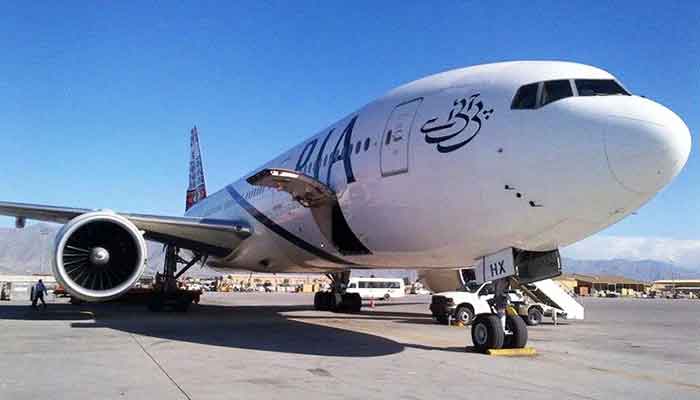IATA’s business plan sees PIA making profit by 2026
The implementation of the plan would see PIA assets going up from the current $1.196 billion to $2.183 billion by 2026
KARACHI: International aviation firm, IATA Consultancy has presented a business plan for Pakistan International Airline (PIA), which if implemented would see the loss-making state owned enterprise making its operations break even by 2025 and record 3.4 percent profits the next year.
The comprehensive business plan covering the period 2022 to 2026 was presented to Minister of Finance and Revenue Shaukat Tarin and Minister of Aviation Ghulam Sarwar Khan on Tuesday.
Secretary aviation, secretary finance, secretary EAD, PIA board of directors and members, PIA CEO and senior officers also attended the meeting.
The implementation of the plan would see PIA assets going up from the current $1.196 billion to $2.183 billion by 2026.
PIA reported a loss of Rs34.6 billion in the financial year 2020. Experts see the losses to have increased significantly in FY2021 because of the pandemic and more importantly the chain of events that ensued following the fake pilot licenses scandal, which saw Pakistani pilots ineligible to fly to US and Europe.
The Ministry of Finance commissioned to prepare the plan last year consequent to the report by the former special advisor to the prime minister on public enterprises reforms Dr Ishrat Hussain.
Dr Ishrat’s report was also termed as a complete restructuring plan for PIA to make it profitable, but also making it a proper business unit, focused on its core operations.
The plan involved financial restructuring to the tune of hundreds of billions of rupees, the officials at the helm of finance ministry and the planning commission demanded a business plan prepared by an international consultant for PIA.
IATA’s consultancy services were hired for that purpose, which after one year has developed a five-year corporate business transformation plan with the current year 2022 as the base year to 2026.
The key points of the business plan encompass, financial restructuring, independent decision making, re-organisation of the company structure, restrictions to core business, financial discipline, HR rationalisation cost controls, review destinations, a fleet planning exercise and network expansion thereby increasing PIA’s network spread and passenger uplift.
PIA’s fleet is expected to grow from the current 29 to 49 by 2026, comprising 16 wide body, 27 narrow body and 6 turbo propeller aircraft. The fleet will be used to expand on current productive routes of UK, Saudi Arabia, UAE and Gulf sectors as well as be operated on identified markets of Baku, Hong Kong, Istanbul, Kuwait, Tehran, Urumqi and Singapore.
Resultantly PIA’s passengers would grow from 5.2 million per annum to 9.0 million per annum, and revenues would grow to $1.7 billion per annum by 2026. These initiatives would help the carrier achieve break even by 2025. PIA, which currently operates 359 round trip flights per week, would be operating 581 round trip flights at the end of the programme.
As GDP and traffic recovery bounce back, propensity to travel should follow, expecting to recover 2019 levels by 2024. According to IATA traffic forecasts for Pakistan, compiled by Oxford Economics, domestic traffic is expected to recover faster than international, coming back to 2019 level by 2022 and 2024, respectively. For this reason, the domestic market should be a priority for PIA in the short- and medium- term.
The outlook also takes into account the global aviation scenarios and challenges, most specifically the Covid-19 pandemic related travel restrictions and reduced demand, and the macro environmental and economic challenges faced by the country.
However, the plan has been made conditional to certain factors, most important of which is the commitment by the government of Pakistan to undertake the financial restructuring of PIA for the legacy debt on its balance sheets and which are beyond the serviceable capacity of the airline.
This would also ease the burden on its cash flows, enabling it to undertake product improvements initiatives, critical for its long-term sustenance.
The plan also urges the government to ensure compliance to the National Aviation Policy, providing a level playing field to the Pakistani carriers.
IATA is of the view that PIA may be run under private management rules, also pertaining to the procurement practices.
It also suggests that external influence on company matters may be curtailed and consistent public scrutiny scaled back as it not only hinders the critical corporate responsibilities of the managers, but also creates negative public relations for the company.
Tarin appreciated the consultant for the comprehensive report. He emphasised that PIA was a national flag carrier, and needed to be a world class airline. He added that the present government believes in reviving and regaining the past glory of PIA and making it a profitable going concern.
He further stressed to focus on the Pakistani diaspora, better customer services and consider the possibility of direct flights in the business plan to make PIA a flourishing organisation that might contribute for economic development of Pakistan and serve communities at home and abroad.
The PIA’s share price increased by 6 percent to Rs4.27 on Tuesday.
-
 Drew Barrymore Gets Candid About The Words That Haunted Her Childhood
Drew Barrymore Gets Candid About The Words That Haunted Her Childhood -
 Why Fans Fell For Scammers Impersonating Reese Witherspoon
Why Fans Fell For Scammers Impersonating Reese Witherspoon -
 'Stranger Things' Star David Harbour Opens Up About Manic Episodes
'Stranger Things' Star David Harbour Opens Up About Manic Episodes -
 Elon Musk Predicts That Solar Power Can Supply The Global Demand For All Of Humanity’s Energy
Elon Musk Predicts That Solar Power Can Supply The Global Demand For All Of Humanity’s Energy -
 Keith Urban Takes Extreme Measures To Not 'air Dirty Laundry' Post-Nicole Kidman Divorce
Keith Urban Takes Extreme Measures To Not 'air Dirty Laundry' Post-Nicole Kidman Divorce -
 Louis Tomlinson Reveals Hidden Anxiety
Louis Tomlinson Reveals Hidden Anxiety -
 Defying Age At Milano Cortina Games: Canadian Skater Stellato-Dudeke Aims For Gold At 42
Defying Age At Milano Cortina Games: Canadian Skater Stellato-Dudeke Aims For Gold At 42 -
 Study Finds Screen Time Does Not Harm Teenagers’ Mental Health
Study Finds Screen Time Does Not Harm Teenagers’ Mental Health -
 'Dunesday': What Robert Downey Jr. And Timothee Chalamet Really Think
'Dunesday': What Robert Downey Jr. And Timothee Chalamet Really Think -
 UK Regulator Reaffirms Ongoing Investigation Into X Deepfake Probe
UK Regulator Reaffirms Ongoing Investigation Into X Deepfake Probe -
 'Marty Supreme' Featured Secret Robert Pattinson Cameo?
'Marty Supreme' Featured Secret Robert Pattinson Cameo? -
 ‘Operation Arctic Endurance’: Which NATO Nations Are Sending Troops To Greenland?
‘Operation Arctic Endurance’: Which NATO Nations Are Sending Troops To Greenland? -
 Kate Middleton ‘disgusted’ As Andrew Points Finger At Her Over Royal Downfall
Kate Middleton ‘disgusted’ As Andrew Points Finger At Her Over Royal Downfall -
 YouTube Adds New Parental Controls For Teens, Limits Shorts Scrolling
YouTube Adds New Parental Controls For Teens, Limits Shorts Scrolling -
 Sarah Ferguson Takes Big Decision As Royal Lodge Eviction Looms
Sarah Ferguson Takes Big Decision As Royal Lodge Eviction Looms -
 Bruno Mars Leaves Taylor Swift Behind With Shocking Move
Bruno Mars Leaves Taylor Swift Behind With Shocking Move




